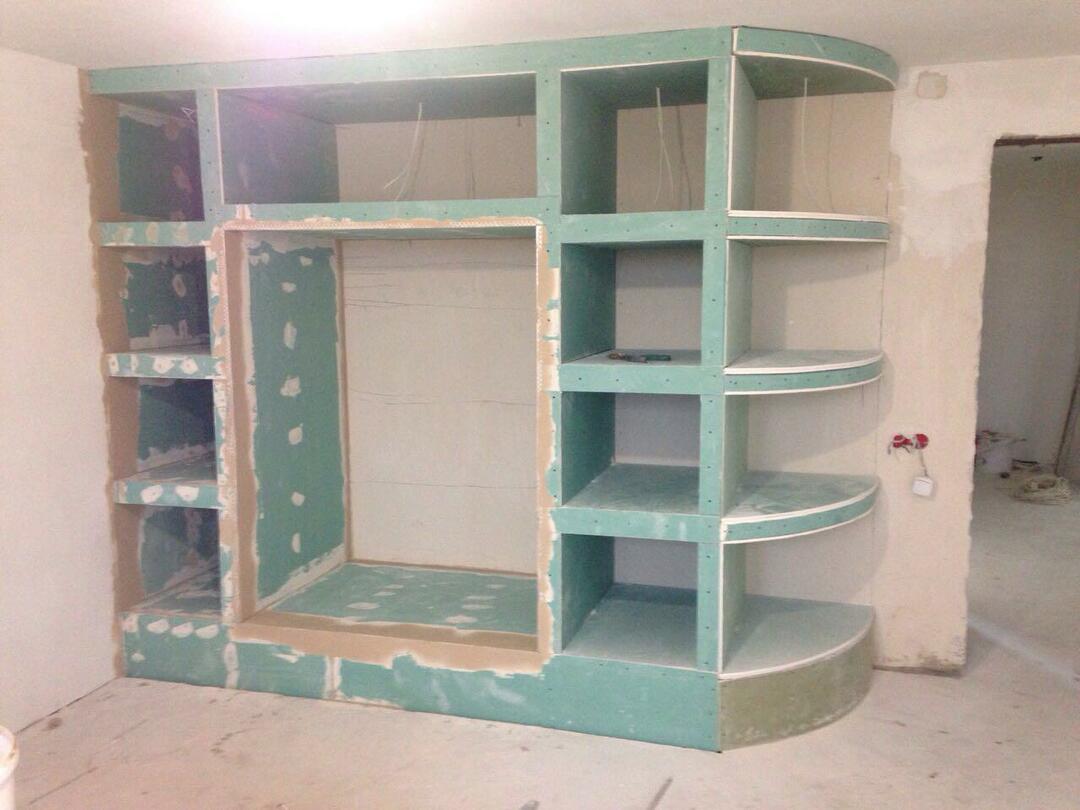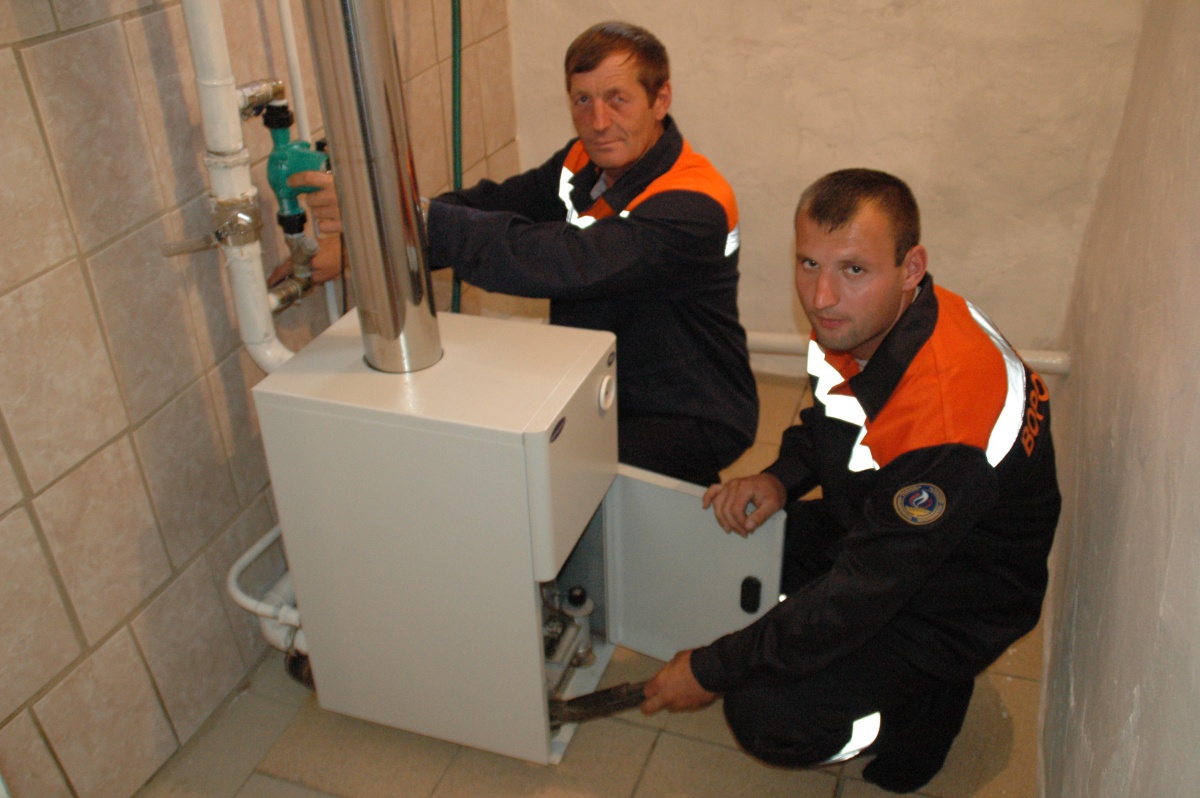The desire to save on utility bills is common to most of us. And you must admit that switching to the use of natural gas for cooking and heating is the most optimal way of such frugality. But ventilation in houses with gas stoves must be built according to very strict rules.
You will learn all about the requirements for the design of the kitchen exhaust system from the article presented by us. We will introduce you to the regulations of the normative documentation covering in detail all aspects of this difficult issue. Let's analyze the standard options for organizing the air mass removal system.
The content of the article:
- Requirements of standards for air exchange
-
Ventilation arrangements for a gas stove
- What can and should be done?
- What is prohibited?
- Conclusions and useful video on the topic
Requirements of standards for air exchange
When designing ventilation in kitchens with gas stoves, it is necessary to comply with the requirements of both sanitary and fire safety standards (GOST, SNiP, SanPiN and SP). Gas supply to apartments and cottages is an undoubted blessing, as it can significantly reduce spending on communal services. But there are a number of points.
Both delivery options: transported by pipes main gas and LPG from a gas tank or cylinder is a source of danger. It is impossible to neglect the prescriptions and forget about the safety rules.

The design and installation of kitchens with gas stoves are regulated by several documents at once. Plus, there are still all sorts of recommendations based on the given standards
If the hood and air flow in the gasified kitchen room is not organized correctly, then the room can become a source of serious problems associated with open fire and the possible explosion of "blue fuel ".
Gas stoves are allowed to be installed both in private houses and in apartment buildings. The height of the building can be no more than 10 floors. At the same time, the premises for them must have a window and be well lit by natural sunlight.
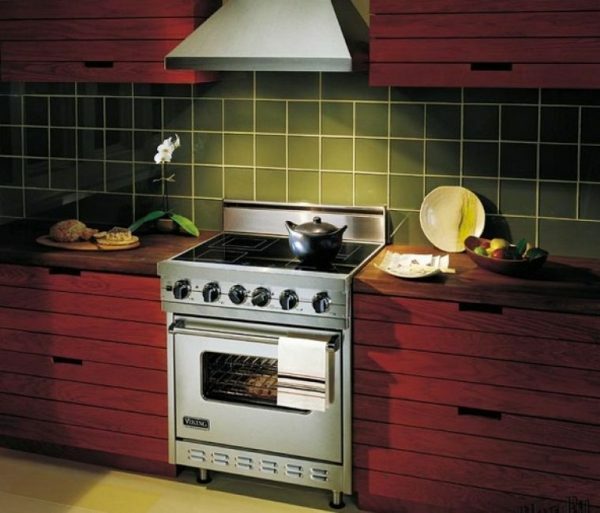
If the air exhaust in the kitchen with a gas stove is insufficient, then when the burner dies out or the pipe bursts, the gas will accumulate in the room and sooner or later will explode
A kitchen for installing a gas stove must:
- be with ceilings with a height of 2.2 m and above;
- have ventilation with natural air inflow / outflow;
- have a window that has an opening sash either at the top of a transom or window.
The cubic capacity of a room with a gas stove should be as small as possible (or better, more):
- 8 m3 - with two burners;
- 12 m3 - with three burners;
- 15 m3 - with four cooking zones.
In some cases, it is permissible to slightly deviate from these norms, but only on condition that such deviations are coordinated with the inspectors from the Ministry of Emergency Situations and other regulatory bodies.
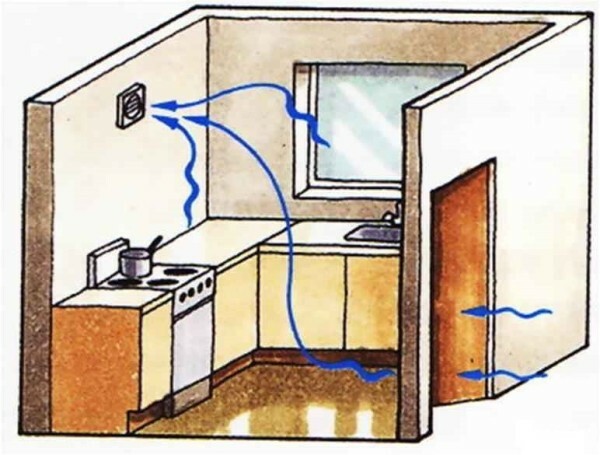
So that there are no problems with the stove, there must be enough air in the kitchen to burn gas, and it must also be constantly replaced by new street
When organizing air exchange in the kitchen it is important to ensure that new air comes exclusively from the street. This will exclude the ingress of air masses with excess odors and moisture, as well as a low oxygen content into the kitchen. Only methane or propane-butane is not enough for gas stove for work.
Air exchange rate for a kitchen with a gas stove - 100 m3/час. At the same time, in most apartment buildings, ventilation ducts with a width of 130–150 mm of the general ventilation system are designed for a flow of up to 180 m3 / hour.
It is only required to provide the required air flow from the outside. In a private house, everything depends on the project. Here you need to look at a specific example, what the existing one is designed for. ventilation system.
Ventilation arrangements for a gas stove
Ventilation in the kitchen where the gas stove is installed can be:
- forced
- with a natural urge;
- combined.
Any option is allowed. However, according to fire safety standards, air exchange in the room in question should be natural. The forced system with a fan is volatile, it is permissible to use it only as an add-on.
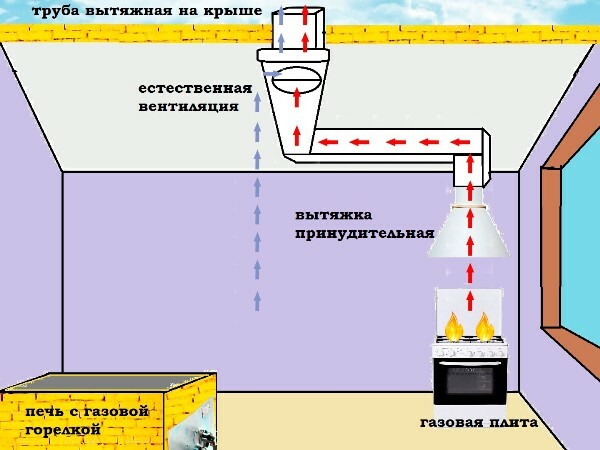
In the presence of a gas stove, forced ventilation in the kitchen is allowed only as an additional hood in an appendix to a system with natural air induction
If the kitchen is extractor hood with fan and bypass to the riser, then for its correct operation:
- it is necessary to ensure the flow of air into the room in the proper volume;
- it is forbidden to close the ventilation duct with natural ventilation with a new branch pipe;
- it is necessary that the ventilation riser be able to pass the volume of air blown into it.
If the ventilation is rebuilt to fit the gas stove in the cottage, then there will be a minimum of problems with the expansion and reconstruction of the ventilation ducts. It only takes money and time to work.
But if a gas stove and ventilation for it are mounted in an apartment of an apartment building, then the situation is often disastrous. Not every high-rise building, if it was not initially included in the project, is designed for the installation of gas equipment in it.
At a minimum, you will have to install window and wall valves for additional flow of outdoor air. Standard ventilation ducts and existing air inlets are hardly designed for the required parameters.
What can and should be done?
If the existing ventilation system is capable of providing an air exchange of 100 m3/ hour, it is enough just to put the cooking oven connected to gas. And you can start preparing your own food. Otherwise, when installing a gas stove, ventilation in an apartment and a cottage will have to be modified in two directions - the first is the inflow, and the second air extraction.

To organize an additional exhaust hood, you will need to lay a new ventilation duct with a connection to the riser above the existing hole from natural ventilation
Additional air flow is provided by:
- drilling a hole in the street outside wall and installing a ventilation valve in it;
- installation of supply valves on kitchen windows;
- increasing the clearance under the door to the kitchen.
In a general situation, air flow is provided from the street and from other rooms of the house. But in the case of a kitchen and a gas stove, most of it should go outside.
In this case, it is permissible that it comes from a window in the bedroom or living room, but then the clearance from the floor covering under the kitchen door will need to be made larger than the standard 15–20 mm. Here the door leaf will have to be lifted by 20-30 mm. If you mount it lower to the floor, then the air exchange will be insufficient.
It is recommended to make supply valves in wall design. Window counterparts in frost can freeze and stop providing air flow. The wall options are larger and free of icing problems.
If the house is old, then without installation of supply valves not enough. Soviet-built buildings were originally designed for ventilation due to the natural flow of air through loose doors and wooden windows.
However, nowadays, double-glazed windows and doors with seals are installed everywhere. As a result, the air exchange rates laid down in the project are violated everywhere, often out of banal ignorance.
As a result, the ventilation system does not cope with the task anyway, and a gas stove is also added, which needs additional volumes of oxygen for operation. Without supply valves air to provide the proper microclimate in living quarters in this case is often impossible.
What is prohibited?
In old houses, ventilation ducts were often made using wooden parts. Plus, they may contain cables for power supply and / or communication systems. In such mines, it is forbidden to remove the outlet from the hood above the gas stove.
Combustion products from a gas stove have an elevated temperature, and also contain water vapor, CO and CO2. You cannot pull such a cocktail into a ventilation duct that is not intended for this.

It is allowed to exhaust air from the gas stove into ventilation ducts, which are made exclusively of non-combustible materials - concrete or steel
On the one hand, ventilation ducts in a kitchen with a gas stove must ensure proper air exchange, and on the other hand, exclude the possibility of ignition from combustion products of natural gas.
Another point is the purchase and installation of a forced hood-umbrella in the kitchen. Sellers of such equipment praise their goods and recommend purchasing equipment more powerful by 900-1100 m3/час. However, high power in this situation is more likely harm than good.
If the ventilation hole in the wall and the riser shaft in diameter are designed for a passage of 180-200 m3/ hour, then they will not physically pump much more through themselves.
Even if the "umbrella" buzzes with all its might and pushes a larger volume of air, the channel will not be able to pump it over. As a result, either the “hood” will start to work idle, or a reverse draft will form in the mine. From both options zero sense.
Difficulties often also arise when the apartment is on the top floor of a high-rise building. In such a situation, ventilation in the kitchen often works poorly. The diameter of the ventilation duct allows for natural air exchange at the proper level, and there is practically no traction.

According to the requirements of regulatory documents, air in house ventilation with natural impulse should move at a speed of approximately 0.5-1 m / s
In order for the required thrust to be formed, the air flow from the room must fall into the vertical pipe, and then pass through it unhindered for at least 2 meters. However, on the top floor, the kitchen vent is located under the ceiling and does not provide the required distance.
Above, only the attic and to the end of the ventilation shaft, which breaks off there, remains less than half a meter. Air exchange occurs as a result, but it is too small for a gas cooking stove.
In this situation, you will have to install an additional vertical pipe of the required height, otherwise it will be impossible to meet the ventilation requirements in a room with a gas stove. A forced draft can solve this problem. But when the light is turned off, the fan will stop working, which is already prohibited by fire regulations.
Conclusions and useful video on the topic
Rules for choosing a kitchen hood with forced induction:
Successful design of a homemade hood for a gas stove:
The most typical violations in ventilation systems in kitchens with gas stoves:
So that a kitchen with a gas stove does not become a place of fire, the ventilation system in it must be with natural impulse and meet the requirements of SNiPs for air exchange rates per hour.
And when installing an additional hood, one must not forget about ensuring proper air flow from the street. Due to its low cost, natural gas saves money, but it is difficult to call it completely safe. You should not neglect the instructions of fire and sanitary standards.
Please leave comments in the block below, post photos on the topic of the article, ask questions. Share your experience with ventilation in a gasified kitchen. Tell us about the technological nuances that will be useful to site visitors.
